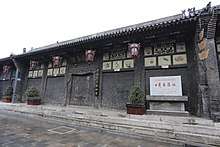Rishengchang

The Rishengchang Piaohao (Chinese: 日升昌票号; pinyin: Rì shēng chāng piào hào), was the first draft bank in China. It's located in Pingyao, Shanxi province, China. "Rishengchang" literally translates to "Sunrise Prosperity", and "Piaohao" means draft banks, predecessors of modern banks in China. It was estimated to be founded during the Qing Dynasty in 1823. In the nineteenth century, at its peak, it controlled almost half of the Chinese economy and its branches were widespread throughout major cities in China, and also in some foreign countries, including Russia, Mongolia, and Japan.
The draft bank is now a museum and in 2006 was included on the List of Major National Historical and Cultural Sites (6-484).
Rishengchang & Piaohao


Rishengchang, the first draft bank or piaohao, originated from Xiyuecheng Dye Company Pingyao in central Shanxi.[1] Rishengchang was estimated to be founded during the Qing Dynasty in 1823. However, the exact founding year remains controversial, some scholars argue it was found in 1797 or 1824.[2] To deal with the transfer of large amounts of cash from one branch to another, the company introduced drafts, cashable in the company's many branches around China. Although this new method was originally designed for business transactions within the Xiyuecheng Company, it became so popular that in 1823 the owner gave up the dye business altogether and reorganized the company as a special remittance firm, Rishengchang Piaohao.
In the next thirty years, eleven piaohao were established in Shanxi province, including Pingyao and neighboring counties of Qi County, Taigu, and Yuci. By the end of the nineteenth century, thirty-two piaohao with 475 branches were in business covering most of China, and the central Shanxi region became the de facto financial centres of Qing China. The Chinese banking institutions of draft bank or piaohao(票号) were also known as Shanxi banks because they were owned primarily by Shanxi merchants. [3]
All piaohao were organised as single proprietaries or partnerships, where the owners carried unlimited liability. They concentrated on interprovincial remittances, and later on conducting government services. From the time of the Taiping Rebellion, when transportation routes between the capital and the provinces were cut off, piaohao began involvement with the delivery of government tax revenue. Piaohao grew by taking on a role in advancing funds and arranging foreign loans for provincial governments, issuing notes, and running regional treasuries.[4]
Rishengchang Code Rule
In 1824, Rishengchang set up a branch in Taiyuan. The main business was cheques or drafts which were called "tickets" in Chinese. At that time, Taiyuan was the base camp of Shanxi businessmen's distribution and maintenance of goods. In order to work efficiently, Rishengchang introduced the world's most advanced printing technology at that time --- the "watermark" method. So Rishengchang used this method to produce and print the "tickets". Additionally, each "ticket" was stamped with a seal in the key parts. Of course, the amounts and recipients of the "tickets" were strictly controlled.
When the Shanxi traders went to other province and the frontier border transaction station, they always brought the drafts which were written by the professional official in Taiyuan Rishengchang using the ink brush. The handwriting must be simultaneously bulletined and sent to other 51 branches of Rishengchang. Specifically, the drafts were executed with codes --- using Chinese writing to replace numbers and regularly changing the password method to prevent disclosure of confidential information.
References
- ↑ Huang Jianhui, Shanxi piaohao shi (Taiyuan: Shanxi jingji chubanshe, 1992), pp. 36-39.
- ↑ The Shanxi Banks.
- ↑ Shanxi Provincial Academy of Social Sciences, ed., Shanxi piaohao shiliao (山西票号史料) (Taiyuan: Shanxi jingji chubanshe, 1992), pp. 36-39.
- ↑ R. O. Hall, Chapters and Documents on Chinese National Banking (Shanghai: Shangwu yinshuguan, 1917), p. 3.
External links